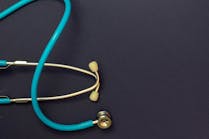In healthcare settings, clinicians and other workers have a whole lot to be mindful of when it comes to protecting their patients and themselves. For instance, sharps are a constant in hospitals and other healthcare settings, and they can cause myriad problems, from the simple risk of being stuck with a needle to harboring bloodborne pathogens that can infect patients and workers alike if exposed.
Healthcare Purchasing News had the opportunity to speak with Amanda Hessels, PhD, MPH, RN, CIC, FAPIC, FAAN, assistant professor of Nursing at Columbia University School of Nursing, and Nurse Scientist at Hackensack Meridian Health, about sharps safety and how workers across multiple disciplines can share knowledge to help one another stay safe. Hessels authored a study in the April 2023 edition of the American Journal of Infection Control entitled “Impact of patient safety climate on infection prevention practices and healthcare worker and patient outcomes,” which comprehensively observed over 5,200 standard precautions and collected over 450 surveys across 43 hospital units.
First, could you tell our readers about your background?
I've been a nurse for 20 years and in that time, I have worked in rural and urban areas, both as a nurse and as an epidemiologist. After working in various clinical care settings, I then shifted to work in a hospital setting again, but this time as an infection preventionist. Infection preventionists are skilled personnel who are so typically under-recognized within healthcare systems, or at least they were, and now they're becoming more broadly known in these settings as the people who really have their feet on the ground, and they keep the pulse in the hospital of who's doing what to help prevent infections.
Do you have any background that you’d like to share on the Needlestick Safety and Prevention Act of 2001?
What was quite striking about that report was that we haven’t moved the needle (no pun intended). When I was a clinical nurse in an ICU years ago, you would see so many novice nurses get pricked by a needle, so we don’t have a true handle on the burden of these needle sticks. Along with the needle stick comes the potential exposure to a potentially infectious pathogen. We’ve now adopted and developed different mechanisms for voluntary event reporting to create a non-punitive environment to encourage healthcare workers to report when these events occur. I think an issue is that most of the work that’s published is really on these percutaneous, not mucotaneous, exposures. If you were to get a needlestick and there’s a splash, it may land in your eyes, nose, or mouth.
There’s a lot of need for improvement within this space, and I think this Needlestick Safety and Prevention Act was a call to action. The risk of exposure has only grown since the act was passed 20 years ago.
How much education and training do healthcare workers receive when it comes to sharps safety?
You have classroom training where you’re educated on what to do, and you have procedural training where you’re educated on how and what to do with regards to administering medication using sharps safety. I’m really pleased to see we have advanced our modalities by which we educate learners, for instance with simulation training. That allows us to not have to train clinicians giving their first-ever injection to a patient in a hospital, and it allows them to practice their skills to gain confidence and competence to allow them to do things correctly every time.
The issue arises after they’re licensed and they’re out in the care space — it’s how often they have the opportunity to practice these skills. Some sites and institutions may do an annual basic training and others will continue to do psychomotor-based training, so that you have to demonstrate that you can still competently conduct this skill when needed.
Do you think there should be more explicitly coming from leadership when it comes to sharps safety?
I think that leaders should encourage the principles of high reliability and safety throughout their organization. If they’re not, then yes, more should happen. I think there is literature emerging on the influential power of organizational leadership from the unit level to the department level, and to the entire system. Having leaders who understand the complexity and who have a handle on what healthcare workers are doing is key.
It's not just coming from the top down, but also having a culture that embraces transparency and using true collaboration to get to the point where you can make meaningful decisions and interventions is important. Leadership should be able to identify nuances across different personnel settings and engage across those settings purposefully.
Could you elaborate on the risk of bloodborne pathogens?
Each one of us is alive because we have blood circulating. When you go into the healthcare setting, they’re going to often want samples of that, and you’re going to have needles and tubes and other devices inserted. Depending on the nature of that, whether it’s a surgical procedure or a childbirth or you’re having an IV, there’s going to be different volumes of and types of blood that could expose that healthcare worker, and the healthcare workers who interact with certain populations of patients are going to vary. That’s not even taking into account the risks of different patient populations who are being treated for known infectious diseases.
Unfortunately, healthcare workers often bring into their decision-making of whether to don and doff PPE factors of patients’ condition, diagnosis, age, race, ethnicity, etc. So, they may say for a 7-year-old going in for a concussion, “Oh, it’s just a 7- year- old. I don’t have to worry about this kid’s blood.” But then, if you have an HIV-positive patient who comes into your department, suddenly everyone’s donning and doffing. But we don’t know what’s in what blood when we’re exposed to it. That’s one thing that drives my program of research — trying to understand what that risk assessment is that providers are making, this sort of occupational psychology of whether they do or don’t adopt different safety practices.
What associations or organizations are trying to get the word out there about sharps safety?
The Association of Occupational Health Professionals (AOHP) has been a tremendous supporter and partner in looking at the intersection between occupational and patient safety. I was also a past research committee chair of the Association for Professionals in Infection Control and Epidemiology, who are also beginning to look at this.
The American Nurses Association has also been doing work on this, as has the CDC and the National Institute of Occupational Safety and Health (NIOSH). I also helped to develop a safety curriculum within the CDC where we could explore some of these issues and opportunities regarding safety to put the tools in the hands of the organization so they could then educate their healthcare workers.
Is there anything else you’d like to share with our readers?
We need to continue to focus on the interdisciplinary nexus in sharps safety — sharps are sharps are sharps. We can generate priority areas across different settings and put them together to develop and innovate solutions we may not have thought of viewed through our own professional lens.

Matt MacKenzie | Associate Editor
Matt is Associate Editor for Healthcare Purchasing News.





